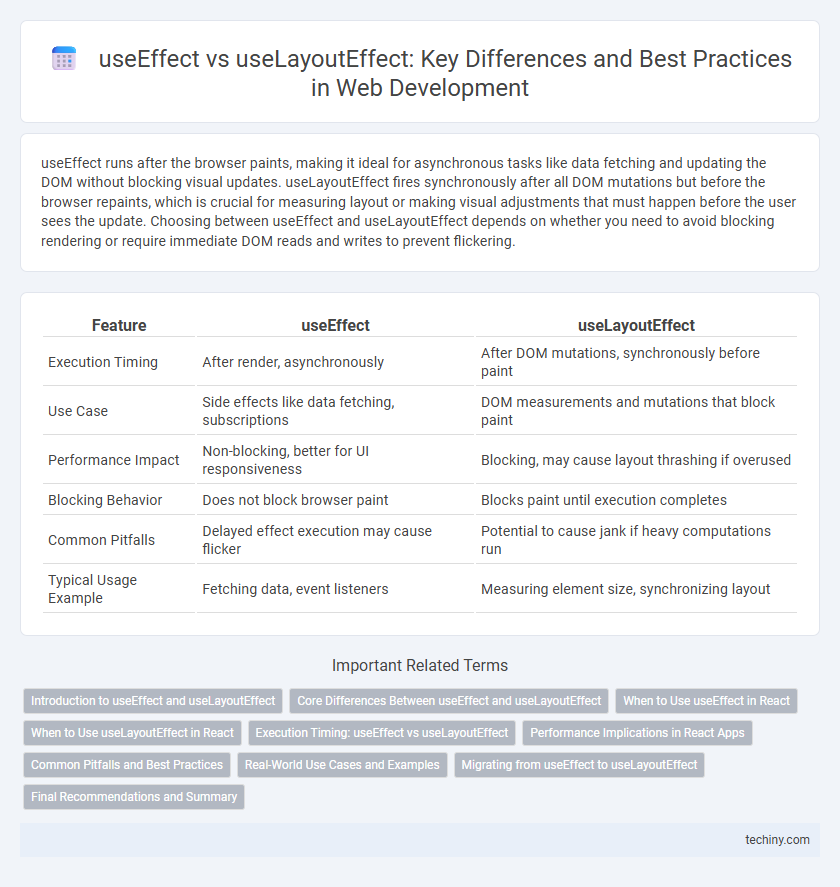useEffect runs after the browser paints, making it ideal for asynchronous tasks like data fetching and updating the DOM without blocking visual updates. useLayoutEffect fires synchronously after all DOM mutations but before the browser repaints, which is crucial for measuring layout or making visual adjustments that must happen before the user sees the update. Choosing between useEffect and useLayoutEffect depends on whether you need to avoid blocking rendering or require immediate DOM reads and writes to prevent flickering.
Table of Comparison
| Feature | useEffect | useLayoutEffect |
|---|---|---|
| Execution Timing | After render, asynchronously | After DOM mutations, synchronously before paint |
| Use Case | Side effects like data fetching, subscriptions | DOM measurements and mutations that block paint |
| Performance Impact | Non-blocking, better for UI responsiveness | Blocking, may cause layout thrashing if overused |
| Blocking Behavior | Does not block browser paint | Blocks paint until execution completes |
| Common Pitfalls | Delayed effect execution may cause flicker | Potential to cause jank if heavy computations run |
| Typical Usage Example | Fetching data, event listeners | Measuring element size, synchronizing layout |
Introduction to useEffect and useLayoutEffect
useEffect runs after the render is committed to the screen, making it ideal for side effects like data fetching and event listeners without blocking UI updates. useLayoutEffect, on the other hand, fires synchronously after all DOM mutations but before the browser paints, allowing DOM measurements or synchronizing layout changes. Choosing between useEffect and useLayoutEffect depends on whether you need to prevent flicker or layout thrashing during rendering in React applications.
Core Differences Between useEffect and useLayoutEffect
useEffect executes asynchronously after the browser has painted, making it ideal for side effects that don't block visual updates, such as data fetching or subscriptions. useLayoutEffect runs synchronously immediately after React has performed all DOM mutations but before the browser repaints, allowing manipulation of the layout before the user sees it. The core difference lies in execution timing: useLayoutEffect blocks paint to prevent flicker during DOM updates, while useEffect allows the paint to proceed, optimizing performance for non-urgent side effects.
When to Use useEffect in React
useEffect in React is best suited for side effects that do not require blocking the browser's paint, such as data fetching, subscriptions, or manually changing the DOM after rendering. It runs asynchronously after the component has rendered, allowing for smooth user interface updates without causing layout shifts or delays. Use useEffect when you want to avoid blocking visual updates and handle operations that do not need immediate DOM measurement or mutation before paint.
When to Use useLayoutEffect in React
useLayoutEffect in React is essential when you need to perform DOM mutations or measurements before the browser paints the screen, ensuring layout consistency and preventing visual flicker. It runs synchronously after all DOM mutations but before the browser updates the screen, making it ideal for reading layout from the DOM and synchronously re-rendering. Use useLayoutEffect for operations like measuring element dimensions, synchronizing scroll positions, or applying animations that must happen before the user sees the update.
Execution Timing: useEffect vs useLayoutEffect
useEffect executes after the browser has painted the screen, making it suitable for side effects that do not block visual updates, such as data fetching or event listeners. useLayoutEffect runs synchronously immediately after all DOM mutations but before the browser paint, which is essential for reading layout and synchronously re-rendering to prevent visual inconsistencies. Choosing between useEffect and useLayoutEffect impacts rendering behavior and performance in React applications, especially for complex UI updates and animations.
Performance Implications in React Apps
useEffect runs asynchronously after the browser has painted, minimizing render-blocking and improving perceived performance in React apps. useLayoutEffect executes synchronously before the browser paints, allowing DOM mutations to be applied immediately but potentially causing render delays or jank. Choosing useEffect is generally recommended for non-critical updates to optimize rendering efficiency, whereas useLayoutEffect suits scenarios requiring immediate DOM read/write for layout calculations.
Common Pitfalls and Best Practices
useEffect is ideal for side effects that don't block browser painting, preventing layout thrashing, whereas useLayoutEffect runs synchronously after DOM mutations but before painting, causing potential performance issues if misused. Common pitfalls include overusing useLayoutEffect for non-critical effects, leading to jank and delayed rendering, and neglecting dependency arrays in both hooks, which can cause infinite loops or stale data. Best practices recommend using useEffect for most side effects and reserving useLayoutEffect for reading layout from the DOM or synchronously re-rendering, while always specifying accurate dependencies to ensure predictable behavior.
Real-World Use Cases and Examples
useEffect is ideal for asynchronous operations like data fetching, event listeners, or subscriptions, ensuring updates happen after the DOM paint to avoid blocking rendering. useLayoutEffect runs synchronously before the DOM updates, making it essential for reading layout properties or making DOM mutations that must occur before the browser paints, such as synchronizing animations or calculating element sizes. For example, useEffect handles API calls to load user data, while useLayoutEffect adjusts scroll position or measures an element right after render for precise layout control.
Migrating from useEffect to useLayoutEffect
Migrating from useEffect to useLayoutEffect requires understanding that useLayoutEffect fires synchronously after all DOM mutations but before the browser paints, enabling immediate DOM updates without visual flicker. This migration improves performance in UI updates dependent on layout measurements or dynamic styles, preventing layout thrashing caused by delayed effect execution inherent in useEffect. Careful refactoring is essential to avoid blocking rendering and maintain smooth user experience, especially in complex React component lifecycles.
Final Recommendations and Summary
useEffect is preferred for most side effects like data fetching and subscriptions due to its asynchronous execution, which avoids blocking the browser painting process. useLayoutEffect should be reserved for DOM mutations and measurements requiring immediate effect before the browser repaints to prevent flickering and layout shifts. Prioritizing useEffect enhances performance and user experience unless precise synchronous updates are essential.
useEffect vs useLayoutEffect Infographic

 techiny.com
techiny.com